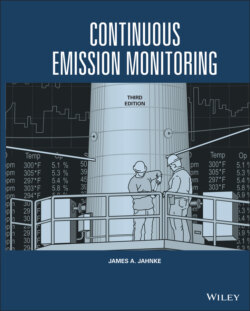Читать книгу Continuous Emission Monitoring - James A. Jahnke - Страница 25
IMPLEMENTING RULES IN THE UNITED STATES
ОглавлениеImplementing rules specify the type of source affected by the rule and may further specify types of process units required to monitor emissions. For example, a Kraft pulp mill recovery furnace may be required to monitor opacity and total reduced sulfur (TRS), or a petroleum refinery sulfur recovery unit may be required to monitor SO2 and H2S emissions through an implementing rule.
The rule should also specify why monitoring is required – its purpose. This may not always be stated or may be ill‐defined, particularly in permits. However, distinctions are important in the case of litigation. Purposes for which CEM systems are typically installed are as follows:
Control equipment operation and maintenance monitoring
Compliance monitoring
Emissions accounting
Public perception monitoring
The first U.S. Federal CEM implementing rules required the installation of CEM systems to monitor the performance of emissions control equipment. Since CEM systems provide a continuous record that shows if a source is either below or above its emissions limits (emissions standards), it was soon noted that the data could also be used for enforcement purposes. Implementing rules followed that required the installation of CEM systems to be used directly for enforcement. Another purpose for the installation of CEM systems is to provide the data necessary to support emissions accounting programs, such as the EPA acid rain program. Pollutant and flow monitoring data are used in these programs to calculate emissions in units of tons per year. A regulatory instrument called an “allowance” is equivalent to a right to emit one ton per year of a given pollutant and a source must have in its possession, the number of allowances equal its mass emissions expressed in tons/year. Here, CEM systems are the measurement tool used to track allowances.
Figure 2‐2 Elements of a CEM rule.
Public perception monitoring (or more euphemistically, “good neighbor” monitoring) refers to more stringent monitoring requirements established for sources such as municipal and hazardous waste combustors. In this case, extensive monitoring requirements are specified, coupled with plant operational interlock criteria where waste feed is shut off if emission limits should be exceeded. The continual oversight given by this instrumentation is intended to provide assurances to the public that environmental concerns associated with these types of sources are being addressed.
In addition to addressing source categories, operational units, and monitoring purposes, implementing rules also specify source specific monitoring details, such as instrument span requirements, data conversion equations, averaging periods, quality assurance, and reporting requirements. These details are important for using the data, but are often overlooked, particularly in state permits. Although there is a greater awareness of the need to specify such requirements in the implementing rules, when they are not incorporated, the rule may be too ambiguous to fulfill its regulatory intent. The variety of implementing rules that require the installation of CEM systems are examined further in the following sections.
